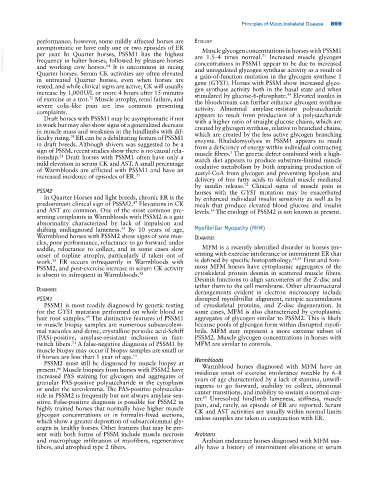Page 903 - Adams and Stashak's Lameness in Horses, 7th Edition
P. 903
Principles of Musculoskeletal Disease 869
performance; however, some mildly affected horses are etIology
asymptomatic or have only one or two episodes of ER Muscle glycogen concentrations in horses with PSSM1
VetBooks.ir frequency in halter horses, followed by pleasure horses are 1.5–4 times normal. Increased muscle glycogen
per year. In Quarter horses, PSSM1 has the highest
71
concentrations in PSSM1 appear to be due to increased
and working cow horses. It is uncommon in racing
64
Quarter horses. Serum CK activities are often elevated and unregulated glycogen synthase activity as a result of
a gain‐of‐function mutation in the glycogen synthase 1
in untreated Quarter horses, even when horses are gene (GYS1). Horses with PSSM show increased glyco
rested, and while clinical signs are active, CK will usually gen synthase activity both in the basal state and when
increase by 1,000 U/L or more 4 hours after 15 minutes stimulated by glucose‐6‐phosphate. Elevated insulin in
49
of exercise at a trot. Muscle atrophy, renal failure, and the bloodstream can further enhance glycogen synthase
72
severe colic‐like pain are less common presenting activity. Abnormal amylase‐resistant polysaccharide
complaints. appears to result from production of a polysaccharide
Draft horses with PSSM1 may be asymptomatic if not with a higher ratio of straight glucose chains, which are
in work but may also show signs of a generalized decrease created by glycogen synthase, relative to branched chains,
in muscle mass and weakness in the hindlimbs with dif which are created by the less active glycogen branching
74
ficulty rising. ER can be a debilitating feature of PSSM1 enzyme. Rhabdomyolysis in PSSM1 appears to result
in draft breeds. Although shivers was suggested to be a from a deficiency of energy within individual contracting
sign of PSSM, recent studies show there is no causal rela muscle fibers. The genetic defect combined with a high‐
3
tionship. Draft horses with PSSM1 often have only a starch diet appears to produce substrate‐limited muscle
21
mild elevation in serum CK and AST. A small percentage oxidative metabolism by both impairing production of
of Warmbloods are afflicted with PSSM1 and have an acetyl‐CoA from glycogen and preventing lipolysis and
increased incidence of episodes of ER. 33 delivery of free fatty acids to skeletal muscle mediated
by insulin release. Clinical signs of muscle pain in
73
PSSM2 horses with the GYS1 mutation may be exacerbated
In Quarter Horses and light breeds, chronic ER is the by enhanced individual insulin sensitivity as well as by
predominant clinical sign of PSSM2. Elevations in CK meals that produce elevated blood glucose and insulin
47
and AST are common. One of the most common pre levels. The etiology of PSSM2 is not known at present.
59
senting complaints in Warmbloods with PSSM2 is a gait
abnormality characterized by lack of impulsion and
shifting undiagnosed lameness. By 10 years of age, Myofibrillar Myopathy (MFM)
34
Warmblood horses with PSSM2 show signs of sore mus dIagnosIs
cles, poor performance, reluctance to go forward under
saddle, reluctance to collect, and in some cases slow MFM is a recently identified disorder in horses pre
onset of topline atrophy, particularly if taken out of senting with exercise intolerance or intermittent ER that
38
work. ER occurs infrequently in Warmbloods with is defined by specific histopathology. 65,69 First and fore
PSSM2, and post‐exercise increase in serum CK activity most MFM horses have cytoplasmic aggregates of the
is absent to infrequent in Warmbloods. 38 cytoskeletal protein desmin in scattered muscle fibers.
Desmin functions to align sarcomeres at the Z‐disc and
tether them to the cell membrane. Other ultrastructural
dIagnosIs
derangements evident in electron microscopy include
PSSM1 disrupted myofibrillar alignment, ectopic accumulation
PSSM1 is most readily diagnosed by genetic testing of cytoskeletal proteins, and Z‐disc degeneration. In
for the GYS1 mutation performed on whole blood or some cases, MFM is also characterized by cytoplasmic
hair root samples. The distinctive features of PSSM1 aggregates of glycogen similar to PSSM2. This is likely
49
in muscle biopsy samples are numerous subsarcolem because pools of glycogen form within disrupted myofi
mal vacuoles and dense, crystalline periodic acid‐Schiff brils. MFM may represent a more extreme subset of
(PAS)‐positive, amylase‐resistant inclusions in fast‐ PSSM2. Muscle glycogen concentrations in horses with
twitch fibers. A false‐negative diagnosis of PSSM1 by MFM are similar to controls.
71
muscle biopsy may occur if biopsy samples are small or
if horses are less than 1 year of age. 15 Warmbloods
PSSM2 must still be diagnosed by muscle biopsy at Warmblood horses diagnosed with MFM have an
present. Muscle biopsies from horses with PSSM2 have insidious onset of exercise intolerance notable by 6–8
66
increased PAS staining for glycogen and aggregates of years of age characterized by a lack of stamina, unwill
granular PAS‐positive polysaccharide in the cytoplasm ingness to go forward, inability to collect, abnormal
or under the sarcolemma. The PAS‐positive polysaccha canter transitions, and inability to sustain a normal can
ride in PSSM2 is frequently but not always amylase sen ter. Unresolved hindlimb lameness, stiffness, muscle
65
sitive. False‐positive diagnosis is possible for PSSM2 in pain, and, rarely, an episode of ER are reported. Serum
highly trained horses that normally have higher muscle CK and AST activities are usually within normal limits
glycogen concentrations or in formalin‐fixed sections, unless samples are taken in conjunction with ER.
which show a greater deposition of subsarcolemmal gly
cogen in healthy horses. Other features that may be pre
sent with both forms of PSSM include muscle necrosis Arabians
and macrophage infiltration of myofibers, regenerative Arabian endurance horses diagnosed with MFM usu
fibers, and atrophied type 2 fibers. ally have a history of intermittent elevations in serum

